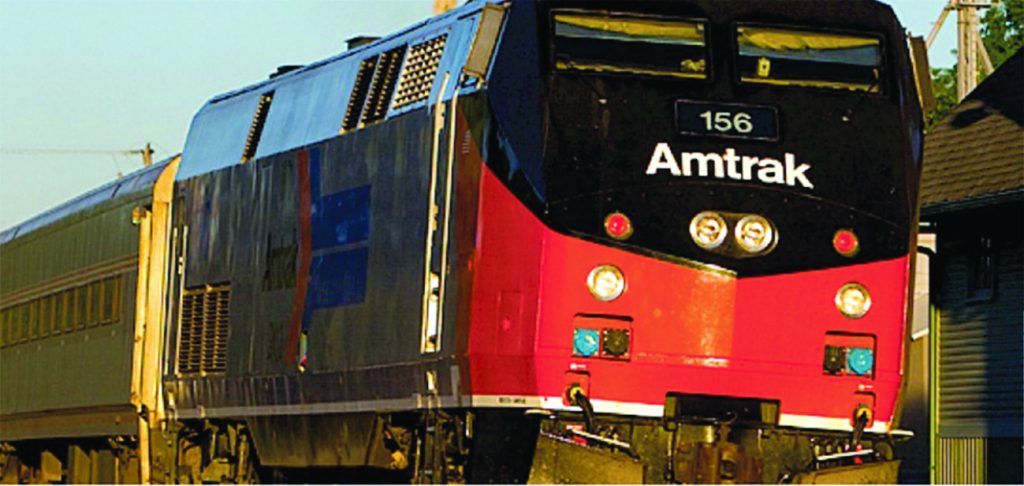
Nancy Edmonds Hanson
hansonnanc@gmail.com
Trains never get a neutral response in Moorhead – not with 70 freight trains splitting the city throughout the average day. But more than 100 local leaders and residents came out Oct. 30 to voice their strong support for a proposal to put another on the rails: A daily passenger train to the Twin Cities that would depart and arrive at reasonable hours.
More than 40 elected and public officials spent the afternoon with Brian Nelson, executive director of All Aboard Minnesota, while 60-plus F-M residents attended the evening session at the Hjemkomst Center. The eight-year-old nonprofit organization advocates for improved, convenient passenger travel between key destinations via Amtrak, the publicly funding passenger service created by Congress in 1971. While cross-country passenger service like the Empire Builder has languished under Amtrak’s current leadership, shorter-distance “corridor trains” that run routes of 750 miles or less are being investigated or running in a number of states, including Illinois, Wisconsin, Michigan and Missouri.
“We want to add Minnesota to that list,” Nelson told his local audience.
Some 20,000 passengers currently use the Fargo-to-St Paul leg of the Empire Builder every year, he said. But its arrivals and departures in the wee hours at 2 to 3 a.m., coupled with its dismal on-time record of 45%, discourage the 11-car trains from increasing their ridership. Reliability increases up to 85% with the shorter corridor service. According to Nelson, experts project that 100,000 additional riders would take the corridor trains, which would provide 280 seats in five cars, including one with dining service. Intermediate stops at Detroit Lakes, Wadena, Staples and St. Cloud would increase the market for the service, proposed to leave the depot in downtown Fargo at 7 a.m. and return at 10:30 p.m. He predicted one-way fares would be similar to the $38 now charged for Fargo-St. Paul travel on the Empire Builder.
Nelson’s group is working with Francis Loetterle, the passenger train planner with the Minnesota Department of Transportation, to investigate the feasibility of corridor trains. Loetterle told Moorheaders that MnDOT’s two first priorities are corridor trains from St. Paul to Chicago and Duluth to the Twin Cities. The Fargo route comes in third. If funding can be developed to support it, the Fargo train could be operational in four years.
One of the key issues for introducing the new train is the availability and condition of tracks – in this case, owned by the BNSF Railway and heavily used for freight traffic. The MnDOT planner noted two advantages along the route: The railroad already has two tracks, compared with only one on much of the Empire Builder’s path; that makes it easier to blend passenger and freight train traffic. And, he said, “It’s some of the best track in the nation. It wouldn’t take much work to add another train running at similar speed,” which he estimated at 80 to 90 miles per hour.
Nelson made the case for both the trains’ comfort and economy. “Decades of public investment in highway and air transportation have created an unbalanced, unsustainable transportation system,” he said. “We believe that given a real choice of fast, frequent trains to multiple destinations, Minnesotans would gladly embrace raid travel again.” He noted that trains are 30% more fuel efficient than automobiles and 20% more than airplanes. In addition, it’s estimated that boosting rail travel ease traffic woes and highway maintenance costs by taking cutting highway travel down by 148,000 cars, and eliminating 25 million road miles each year in the state.
Mayor Johnathan Judd, who attended both sessions, introduced the evening’s program by pointing by the contribution of better passenger rail travel could make to economic development. “We are on the verge of great things here in Moorhead, and something like this can really change the game,” he said. “We need to embrace thinking outside the box. Not only would it be convenient and, I think, popular with our residents and visitors alike. Passenger rail service fits well into our focus on sustainability.
“If you live in Moorhead, the topic of trains is never neutral. You can disdain them, or you can love them. We need to look at the positives. This train will help connect us with our state and beyond.”
For more information on the proposed corridor service in Minnesota and steps required to make it a reality, visit allaboardmn.org.


